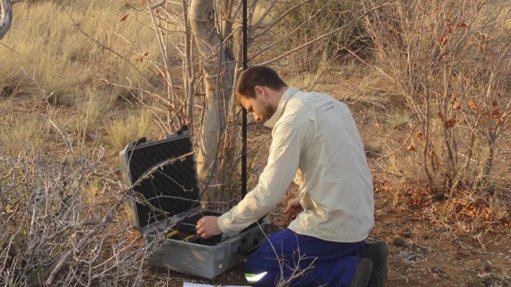
WORK PLAN Peregrine Diamonds’ 2015 diamond exploration programme focused on two main target verification projects at Moralane and Malolwane, including drill testing
Photo by: Peregrine Diamonds
TSX-listed explorer Peregrine Diamonds’ 2016 planned work programme for its Botswana diamond exploration programme is expected to start this month and will continue until late November, the company announced late last month.
Peregrine’s primary assets in Botswana are 11 prospective diamond prospecting licences that cover 6 613 km2.
In expanding its land position in Botswana, Peregrine has acquired a new prospecting licence, which includes the diamond-bearing Sikwane kimberlites.
The 2016 work programme will focus on core drilling of the Sikwane kimberlites and target verification in the Mmashoro and Sikwane project areas.
The programme will focus on target drilling and target verification by ground truthing. The company explained in a statement last month that target testing through core drilling would be prioritised on the Sikwane licence.
The Sikwane licence covers 453 km2 and hosts previously drilled diamondiferous kimberlite intersections, with kimberlite indicator mineral (KIM) chemistry and unresolved KIM and magnetic anomalies, according to the company.
The kimberlites were originally discovered by diamond major De Beers in 1997.
About 500 m of core drilling is planned to test five pre- viously identified diamondiferous kimberlitic occurrences. These targets are supported by drill logs submitted by previous operators.
The company further stressed that key to the programme was the “resolution of the emplacement morphology of the kimberlitic material” and “to determine the potential for hosting economic volumes of diamond bearing kimberlite”.
Meanwhile, target verification would focus on the Mmashoro area, which has unresolved aeromagnetic anomalies in a terrain where kimberlites predominantly presented with magnetic signatures, as well as the Sikwane area, where several discrete aeromagnetic anomalies remained unresolved, the company noted.
Activities in these two areas will include further KIM sampling, as well as detailed ground geophysical surveys.
The company’s 2015 diamond exploration programme focused on two main target verification projects at Moralane and Malolwane, included drill testing of four priority kimberlite targets in the Moralane block, as well as limited target generation work at Gope and Nata.
The Moralane licence covers 664 km2 and hosts a compelling KIM anomaly, with asso- ciated isolated magnetic anomalies. Microprobe-confirmed KIM compositions define a unique, diamond-compatible signature that cannot be matched to indicators from known kimberlite clusters in the region. According to Peregrine, previous operators in the area focused their drilling on the highest indicator mineral counts and drilled shallow holes to reach the basal Kalahari sequences.
About 170 km of high resolution ground magnetics were acquired over 11 targets in the Moralane licence. The results were used to identify and prioritise four drill targets possibly representing syn- or pre-Karoo intrusives that would be deeper than previous drilling. A total of 570 m of reverse-air blast drilling was completed on the four targets in 2015. No kimberlites were intersected.
In the Malolwane licence, which covers 251 km2, a KIM sampling programme was completed during which 288 samples were collected. Several KIMs were recovered, including ilmenite and chromite. Additional in-fill KIM sampling to define drill targets is being planned.
Peregrine’s other licences include Gope, where two licences cover 1 001 km2. Peregrine has identified 20 priority magnetic targets, following a reinterpretation of the Gope low-level aeromagnetic survey.
Ten of these targets were prioritised for target-scale KIM sampling and forty 60 l screened samples were collected during November 2015. The samples were submitted for KIM extraction and a kimberlitic garnet was recovered from one of the targets.
The company noted that low-count KIM recoveries are significant in thick Kalahari sand-covered areas and further work at Gope was planned.
Peregrine also holds four licences covering 3 830 km2 at Nata. While regional airborne geophysics had highlighted a number of mag- netic anomalies in an area favourable for kimberlite intrusives, this programme had not been prioritised for any exploration work during the year, the company concluded.